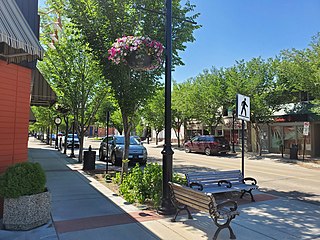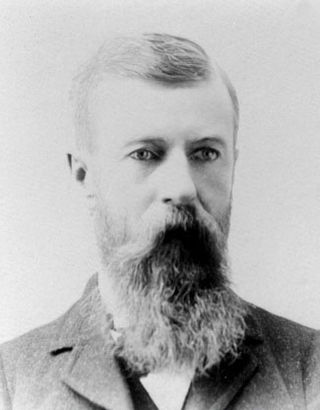
Edmonton is the capital city of the Canadian province of Alberta. Edmonton is situated on the North Saskatchewan River and is the centre of the Edmonton Metropolitan Region, which is surrounded by Alberta's central region. The city anchors the northern end of what Statistics Canada defines as the "Calgary–Edmonton Corridor", a region spanning between Edmonton and the city of Calgary, Alberta's largest city, which includes the many smaller municipalities between the two.

A grain elevator is a facility designed to stockpile or store grain. In the grain trade, the term "grain elevator" also describes a tower containing a bucket elevator or a pneumatic conveyor, which scoops up grain from a lower level and deposits it in a silo or other storage facility.

Edmonton Strathcona is a federal electoral district in Alberta, Canada, that has been represented in the House of Commons of Canada since 1953. It spans the south-central part of the city of Edmonton. In the periods 2008–2015 and 2019–2021, during the 40th, 41st, and 43rd Canadian Parliaments, Edmonton Strathcona was the only federal riding in Alberta not represented by the Conservative Party.

Fort Saskatchewan is a city along the North Saskatchewan River in Alberta, Canada. It is 25 kilometres (16 mi) northeast of Edmonton, the provincial capital. It is part of the Edmonton census metropolitan area and one of 24 municipalities that constitute the Edmonton Metropolitan Region Board. Its population in the 2021 federal census was 27,088.

Old Strathcona is a historic district in south-central Edmonton, Alberta, Canada. Once the commercial core of the separate city of Strathcona, the area is now home to many of Edmonton's arts and entertainment facilities, as well as a local shopping hub for residents and students at the nearby University of Alberta. The district centres on Whyte Avenue and has shops, restaurants, bars and buskers.

Watson's Mill is an historic flour and gristmill in Manotick, Ontario, Canada. It is the only working museum in the Ottawa area and one of the very few operating industrial grist mills in North America. Watson's Mill still sells stone-ground whole wheat flour which is made on site. The mill is also well known for its ghost Annabelle. The legend is that Ann Currier, wife of Joseph, haunts the mill, following her death in a tragic accident there in 1861. Watson's Mill is Manotick's most recognized landmark. Its image is used as a symbol for the village.
Strathcona was a city in Alberta, Canada on the south side of the North Saskatchewan River. Originally founded in 1891, it amalgamated with the City of Edmonton in 1912.

Mill Creek Ravine is located in Edmonton, Alberta, Canada and is a part of the River Valley parks and trail system. It contains the last stretch of Mill Creek, before it flows into a culvert for its end run to the North Saskatchewan River. The ravine ends where the land opens onto the North Saskatchewan River valley near the west end of Cloverdale on the opposite bank from downtown.
Strathcona is a residential neighbourhood in south central Edmonton, Alberta, Canada. It is a part of, and should not be confused with, Old Strathcona, although much of the Strathcona neighbourhood is in Old Strathcona. The neighbourhood overlooks both the North Saskatchewan River and the Mill Creek Ravine.

John Cameron[n1] was a merchant and politician in Alberta, Canada and a municipal councillor in Edmonton. He is regarded as one of the city's pioneer citizens.

South Edmonton station, known as Strathcona station prior to 1932, was built by the Calgary and Edmonton Railway in what was then the City of Strathcona, Alberta. Construction on the station was started in 1907, completed in 1908, and expanded in 1910.
The timeline of Edmonton history is a chronology of significant events in the history of Edmonton, Alberta.
The Krause Milling Co grain elevator and flour mill site complex is composed of a 1929 grain elevator, drive shed, office/powerhouse, storage building and foundation of the 1929 flour mill, in the center of Radway, Alberta.
The Lake of the Woods Milling Company Limited was a milling company that operated a flour mill in Keewatin, Ontario for 79 years. At the height of its production, it was possibly the largest flour mill in the British Commonwealth.

The Strathcona Library, one of the oldest libraries in Alberta, completed in 1913, was the first library erected in the City of Edmonton. Nevertheless, the Strathcona Library does have a complex background as to its historical status within the Edmonton Public Library system. It is located on 104th Street, a block off of Whyte Avenue in the heart of Old Strathcona. Situated next to Wilbert McIntyre Park, the iconic Old Strathcona Gazebo, and the year-round Old Strathcona Farmer's Market, the Strathcona Library is often a central gathering area for much of the local community. During the annual Edmonton International Fringe Festival in the surrounding area, the Strathcona Library often hosts a large booksale to help shift aging and excess material from Edmonton Public Library's circulation.
The Esterhazy Flour Mill is located at 517 Smith-Dorrien Street, Esterhazy, Saskatchewan. Construction of the mill was started in 1904 and was completed in 1907. The current owner is the Town of Esterhazy and is run by the Friends of the Flour Mill. The Esterhazy Flour Mill is the only remaining wood-frame construction flour mill in Saskatchewan. The Provincial Heritage Property designation was announced in 2005 and on July 8, 2009, the Esterhazy Flour Mill was designated as a National Historic Site.












